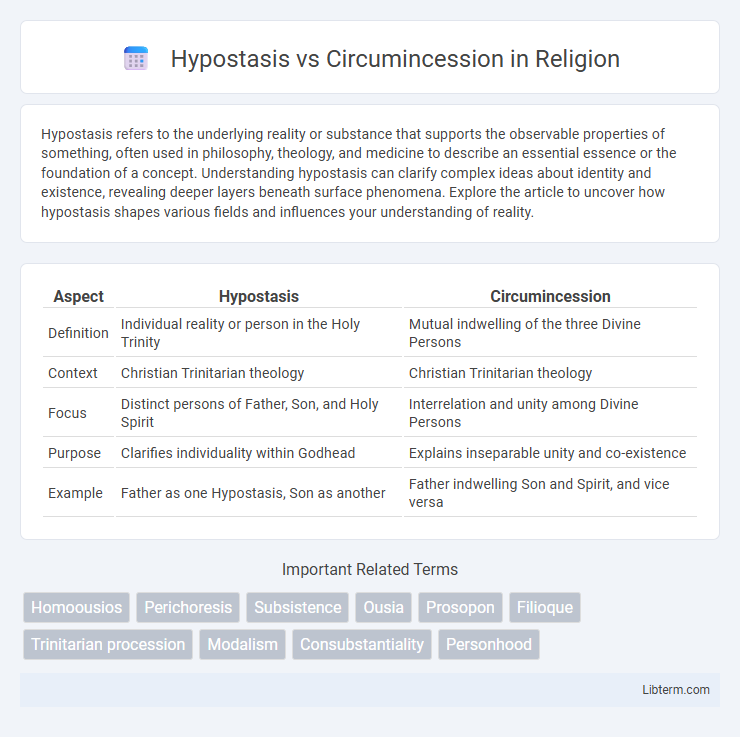Hypostasis refers to the underlying reality or substance that supports the observable properties of something, often used in philosophy, theology, and medicine to describe an essential essence or the foundation of a concept. Understanding hypostasis can clarify complex ideas about identity and existence, revealing deeper layers beneath surface phenomena. Explore the article to uncover how hypostasis shapes various fields and influences your understanding of reality.
Table of Comparison
| Aspect | Hypostasis | Circumincession |
|---|---|---|
| Definition | Individual reality or person in the Holy Trinity | Mutual indwelling of the three Divine Persons |
| Context | Christian Trinitarian theology | Christian Trinitarian theology |
| Focus | Distinct persons of Father, Son, and Holy Spirit | Interrelation and unity among Divine Persons |
| Purpose | Clarifies individuality within Godhead | Explains inseparable unity and co-existence |
| Example | Father as one Hypostasis, Son as another | Father indwelling Son and Spirit, and vice versa |
Introduction to Hypostasis and Circumincession
Hypostasis refers to the individual reality or underlying substance of a being, particularly in theological contexts such as the three persons of the Trinity in Christian doctrine. Circumincession describes the mutual indwelling or interpenetration of these distinct hypostases, emphasizing their unity without confusion or separation. Both concepts are fundamental to understanding the relational and ontological dynamics within the Trinity, illustrating how distinct persons coexist in one divine essence.
Historical Context and Theological Origins
Hypostasis and circumincession are critical theological terms developed during early Christian councils to clarify the nature of the Trinity. Hypostasis, meaning "underlying reality" or "person," emerged prominently in the Council of Nicaea (325 AD) to articulate the distinct persons of Father, Son, and Holy Spirit. Circumincession, or perichoresis, originated in Eastern Patristic theology to describe the mutual indwelling and interpenetration of these divine persons, emphasizing their unity without confusion.
Defining Hypostasis in Christian Doctrine
Hypostasis in Christian doctrine refers to the concrete, individual reality or person within the Godhead, distinct from ousia, which signifies the shared essence or substance of God. It defines the three distinct Persons--Father, Son, and Holy Spirit--each fully God yet distinct in personhood, maintaining unity in the Trinity without division or confusion. The concept of hypostasis is crucial to articulating orthodox Trinitarian belief, distinguishing personal identities within one divine nature.
Understanding Circumincession (Perichoresis)
Circumincession, also known as Perichoresis, refers to the intimate interpenetration and indwelling of the three persons of the Holy Trinity -- Father, Son, and Holy Spirit -- without merging or confusion of their distinct identities. This theological concept emphasizes the dynamic, relational unity and co-inherence of the divine persons, reflecting perfect mutual indwelling and love. Understanding Circumincession clarifies how each person remains fully distinct yet completely united, contrasting with Hypostasis, which identifies each person as an individual reality or subsistence within the Godhead.
Scriptural Foundations for Both Concepts
Hypostasis is rooted in biblical texts such as Hebrews 1:3, where the Son is described as the "exact representation" of the Father's being, affirming distinct individual realities within the Godhead. Circumincession, supported by passages like John 10:30 ("I and the Father are one"), emphasizes the mutual indwelling and unity of the Father, Son, and Holy Spirit. Scriptural foundations reveal hypostasis as distinct persons and circumincession as their inseparable interpenetration in the Trinity.
Distinctions Between Hypostasis and Circumincession
Hypostasis refers to the underlying reality or substance of a being, especially used in theological contexts to denote the distinct persons of the Trinity, whereas circumincession describes the mutual indwelling or interpenetration of these persons without loss of their individual identities. Hypostasis emphasizes individuality and personal distinction, while circumincession highlights the unity and co-inherence within the Godhead. The key distinction lies in hypostasis identifying distinct persons and circumincession illustrating their inseparable communion.
Significance in Trinitarian Theology
Hypostasis and Circumincession are pivotal concepts in Trinitarian theology, with hypostasis referring to the distinct persons (Father, Son, Holy Spirit) each possessing a unique personal identity within the Godhead. Circumincession, or perichoresis, denotes the interpenetration and mutual indwelling of these three hypostases, emphasizing their unity without confusion or division. Understanding this dynamic relationship clarifies the coexistence of three distinct persons sharing one divine essence, a cornerstone of orthodox Christian doctrine.
Role in Christological Debates
Hypostasis and circumincession played pivotal roles in early Christological debates by addressing the nature of Christ's personhood and divine-human relationship. Hypostasis refers to the individual reality or person, distinguishing the Father, Son, and Holy Spirit as distinct persons in the Trinity, whereas circumincession describes the mutual indwelling or interpenetration of the divine persons without confusion or division. These theological concepts helped clarify orthodox doctrine against Arianism and Nestorianism by affirming Christ as one person (hypostasis) with both divine and human natures united inseparably through the communion of the Trinity (circumincession).
Contemporary Interpretations and Misunderstandings
Contemporary interpretations of hypostasis and circumincession often reveal confusion between these theological concepts due to their complex nature in Trinitarian doctrine. Hypostasis refers to the distinct persons within the Godhead, emphasizing individuality without division, while circumincession describes the mutual indwelling and inseparability of these persons. Misunderstandings arise when circumincession is oversimplified as mere coexistence, neglecting its profound implication of dynamic relational unity within the Trinity.
Conclusion: Theological Importance Today
Hypostasis and circumincession remain crucial in contemporary theology for understanding the relationship within the Trinity and the union of divine and human natures in Christ. Hypostasis refers to the distinct persons of the Father, Son, and Holy Spirit, while circumincession describes their mutual indwelling, emphasizing unity without confusion. This distinction shapes modern Trinitarian doctrine, ensuring a balanced comprehension of individuality and communion within the Godhead.
Hypostasis Infographic

 libterm.com
libterm.com